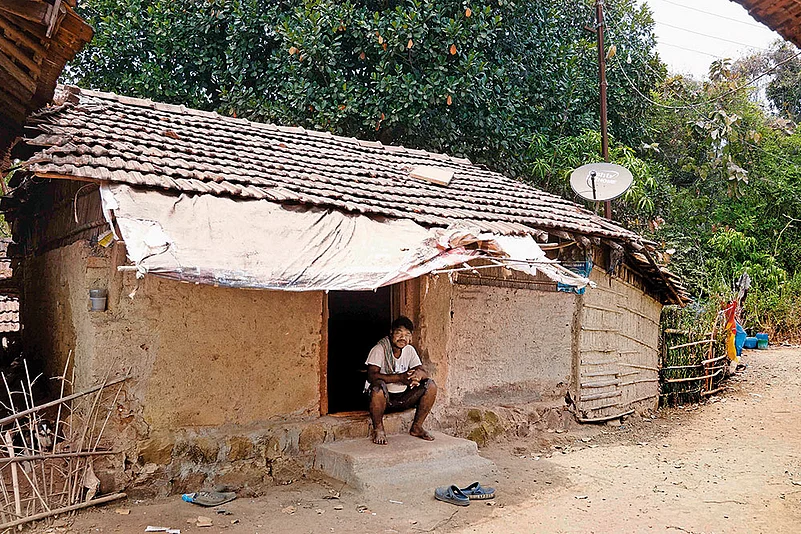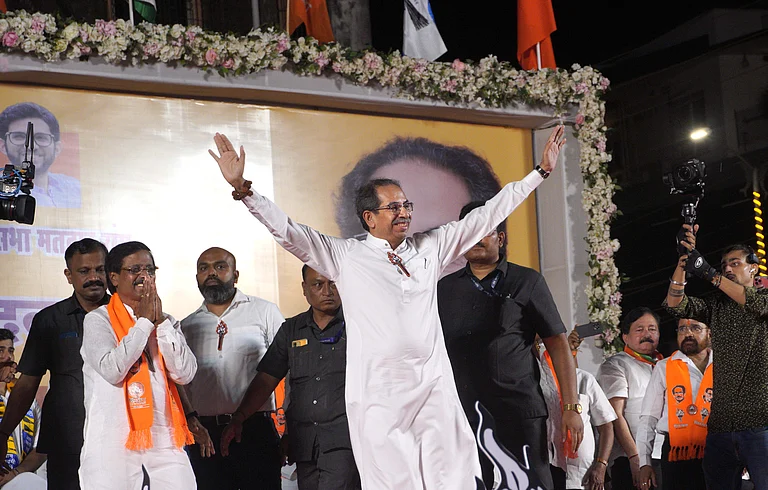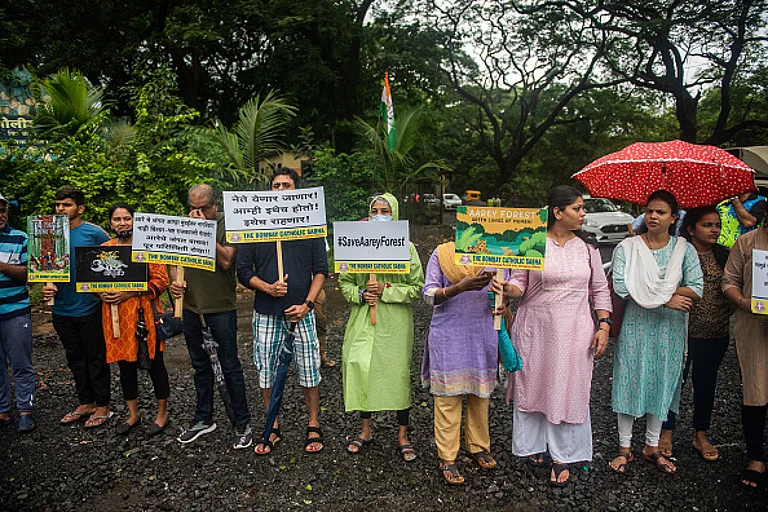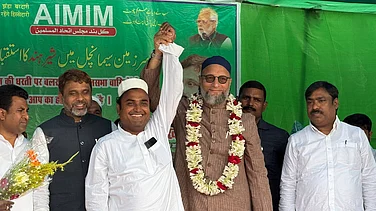Around 180 km from Mumbai—the commercial capital of the country—it’s a different world. Beyond the last concrete stretch of the Pradhan Mantri Grameen Sadak Yojana, there are no motorable roads. One must walk. Apart from the silence and the salty breeze of the Konkan region—a respite from the climbing heat on an April noon—there is hardly anyone on the road. For quite a long stretch, there is dried grass, sand, dust and stone. But after a few minutes, one starts spotting mud huts. A few men peep out of the doors and stare at you curiously, as if asking—who are you and why are you here?
This hamlet in Wave Diwali village in Raigad district rarely finds a mention in the electoral map of the state. The Katkari community, which has been living here for centuries, is hardly counted as a ‘vote bank’. They form 11 per cent of Raigad’s population, and hence do have a considerable electoral significance, but the ground reality is contrary to the numbers. “The leaders throw money at them just 48 hours before the polls and take them away, but no one comes here after the elections,” says a local political activist.
The Katkari community is enlisted as a Particularly Vulnerable Tribal Group (PVTG) and their population is spread across Raigad, Thane and Pune districts of Maharashtra. Traditionally, the community used to specialise in extracting Katha or Catechu—thickened sap of Khair wood, a thorny plant found in these regions, scientifically known as Senegalia Catechu—that has medicinal value. “However, this trade is a matter of the past now. Big players of the medical industry have taken over. So, now they have no option but to work in the farms of Marathi farmers,” says Ulka Mahajan, a social activist, who has been working with this community for decades.
While most of the Katkaris don’t own land, monocrop fields and forest reservations have added to their woes. “In this region, paddy is the main crop. Though ragi and wari are also cultivated, but those who don’t have land have to do more for a living,” adds Mahajan. Paddy is sown in June-July, and is reaped in November-December. After this, the people are left with no work, so they start working at coal and brick kilns and inadvertently get embroiled in the cycle of exploitation.
***
Sitting inside one of the mud houses in Wave Dilwali village that are spread across the forest and the Gani Hills, resident Ram Vagya Pawar tells their stories—the unheard realities that never find place in the high-pitched electoral battles of Maharashtra. Pawar, now in his thirties, never went to school. He has been working and doing odd jobs for as long as he can remember. “During paddy season, my parents used to work in the lands owned by the Kunbis (one of the several castes of traditional farmers). During festivals like Diwali or Ganesh Chaturthi, they used to take money from seths to buy new clothes and good food. After that, it was their turn to work in seth’s bhatti (brick kilns/ coal kilns) till the amount was repaid,” says Pawar.
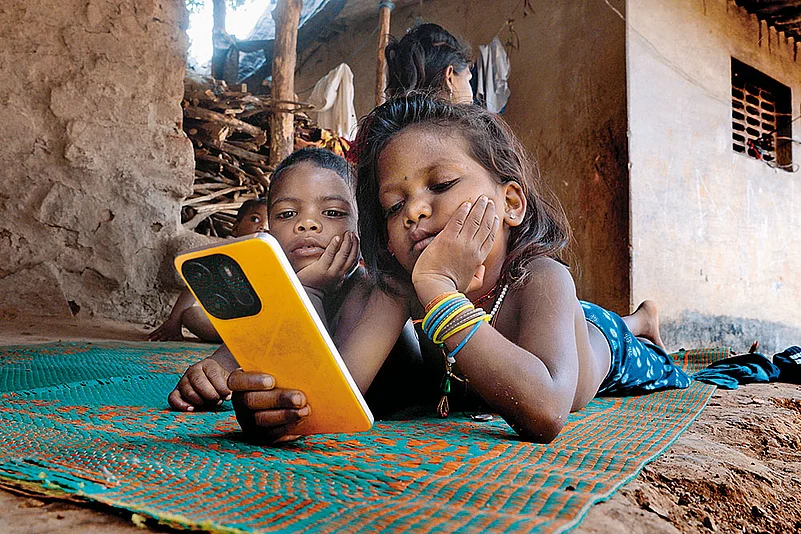
As a child, he used to accompany his parents to the brick kilns and the practice continued even after he became an adult. Last year, Pawar borrowed Rs 60,000 from his seth during Diwali. “This is when we get to buy new clothes, eat mutton and bhakri (roti made with rice flour).” He then went to Mangoan, the nearest tehsil headquarters, to work at a brick kiln so that he could repay the loan. For every 1,000 bricks, they get Rs 1,000. He, along with his wife, used to make 700 bricks a day. “We worked there for almost four months and came back to the village in April. From June, the paddy season will start, and we will again work on the fields of the kunbis,” he adds. The cycle continues.
Just like his father, Pawar also takes his son to the kilns as the village almost remains khaali (empty) during this season. His son has managed to study till Class 10. Every month, they get 35 kg of grains under the Antyodaya Anna Yojana. However, till now, they have not been able to avail the benefits of the Pradhan Mantri Awas Yojana (PMAY) and have not received a cylinder under the Ujjwal Yojana.
Two houses away from Pawar lives Rajaram Babu Waghmare in his half-cemented, yet-to-complete house. Pushing his frail body against the sack of rice that he recently received from the ration counter, Waghmare says: “Our problems will never be solved unless we get ownership of the forest.”
In the Konkan region, the forest land on the hills is known as Dali land. In 1887, the British government gave the rights of these lands to Adivasis. In Raigad alone, there are about 13,000 hectares of Dali land on which the Katkari Adivasis depend for their livelihood.
After Independence, the Indian government accepted their undisputed claim over these lands. In 1971, the state government asked the forest department to clear these lands for cultivation and hand them over to the Adivasis—mostly to the Katkari community. However, the locals claim that less than 10 per cent of it has been transferred so far. In 1976, the forest was brought under the concurrent list and in 1980, the Forest Conservation Act was passed. The state government said that without consulting the Centre, they would not be able to implement the earlier decision, and this led to the status quo.
The Adivasis did not sit quietly. With the support of different civil society members, Campaign for Survival with Dignity was formed. It brought multiple groups together to demand a policy to ensure the rights of forest dwellers on forest land. This collective action led to the passing of the Forest Rights Act (FRA) in 2006. “However, the fate of the Katkari Adivasis did not change as the process of giving them their land back was repeatedly delayed,” says Mahajan, who runs Sarvahara Jana Andolan—a social organisation that has been upholding the rights of marginalised communities for decades. Only recently, they received primary certificates of community ownership of Dali lands.
While showing the land certificate titled Samuyik Banahakka Dharkanchanao (community land ownership) that gives ownership and protection rights of 14.81 acres of forest land to 17 Katkari families in Wave Diwali, Waghmare says: “This is not enough. They wouldn’t let us cut the big trees and until the lands are cleared for cultivation, it’s of no use.” Chandrakant, another social activist, explains: “They need separate lands, not the community holdings. They need to grow paddy, ragi or wari for survival. But the forest department is not letting it happen.”
Though Waghmare owns 32 guntha or 0.75-acre of land, his son and daughter-in-law are working at coal kilns in Andhra Pradesh. They borrowed Rs 80,000 from their seth during Ganesh puja. “They have to repay the loan,” he says.
The Katkari community is enlisted as a Particularly Vulnerable Tribal Group (PVTG) and their population is spread across Raigad, Thane and Pune districts of Maharashtra.
These issues of the Katkari Adivasi community do not find any place in the electoral campaigns in Raigad, one of the 48 Lok Sabha constituencies of Maharashtra that votes on May 7. In this seat, the fight is quite interesting as Sunil Tatkare, the former NCP leader and an aid of Sharad Pawar, is contesting the election from the Ajit Pawar camp. Tatkare won the seat in 2019 with the blessings of the senior Pawar.
The INDIA bloc has fielded senior Shiv Sena leader—now in the Uddhav Balasaheb Thackeray (UBT) faction—and former union minister Anant Geete, who is evoking the trope of ‘betrayal’ to corner Tatkare. Amid this political mudslinging, the concerns of the Katkari community and their rights are getting pushed to the corner. When asked if he has any plans for the community, Tatkare says: “They are not Katkaris. We call them Adivasis. Every one of them has got 2.5 acres of forest land as per the Forest Conservation Act. In my constituency, I have given them roads, schools and Anganwadis.”
However, people from the Katkari community that this reporter spoke to have a different opinion. While Pawar and Waghmare asked for CC roads that can connect them to the main village, around 20 kms away, in Ratwad, another small hamlet, Katkaris seem sceptical about the works done by the MP. Village sarpanch Vaishali Gangaram Jadhav, standing at the end of the hilly and dusty lane that is flanked by mud houses, says: “Road connectivity is the real issue here. I will request the new government to give us internal CC roads towards the school and the crematorium.” She also requested for disbursement of PMAY funds so that they can make pucca ghar. Of the 50 houses in the village, only 16 have received the funds so far. Seven houses were made under the state-sponsored Shabari Adivasi Gharkul Yojana—a targeted scheme for cementing Adivasi houses in the village hamlets.
Though there is a small school around 2 km from the Adivasi hamlet, students from the Katkari community rarely get the chance to go to school as they are constantly migrating with their parents. “My son is now in Class 5, but he still cannot write his name. Every year in November, we take him with us to the coal kiln and he is not able to attend classes for 5-6 months,” says Kushana Ramajangam, who, these days, is working day in and day out to make a pucca house, as his daughter is going to get married soon.
Ramajangam never went to school but understands the importance of education. “Because we are uneducated, the seth can dupe us,” he says. Last year, he took Rs 30,000 from his seth during Diwali, and in November, with his wife and son, went to a coal kiln in Andhra Pradesh. “For every gani (sack) of coal produced from the woods of Babul trees, we get Rs 130. In these last four months, we produced 170 ganis. Yet, our seth told us, we still have to repay Rs 25,000,” he elaborates. When he was told that he has already paid around Rs 22,000, he says: “The seth cuts the amount for ration and medical bills as well. We can’t do basic calculations. Whatever he says, we have to accept.”
***
The silence in the room was interrupted by Ravi Ramesh Jadhav, 14, who was searching for something beneath the calendar of Asaram Bapu whose team recently visited the village and gave them these photos and a few new clothes. As the Godman-turned-convict stares at Ravi from his large size photo—a misfit in a Katkari household, Ravi says: “The teacher is Maharashtrian, and is biased towards Adivasi students.” Ravi and his friends, who now study in Class 8, can’t even recite the table of five.
While basics like education, medical facilities, road connectivity and homes are in tatters, two things bind them—mobile phones and television. Looking at a few children who were watching reels on mobiles, sitting on the broken stairs of muddy courtyards, Vaishali says: “We need the mobiles as our seth calls us whenever there is work.” Even in the interiors, the mobile network was not an issue. For Tatkare, that was something worth mentioning in his election rally. “Every single Adivasi household now has a television and mobile phone,” he said.
“Among the Katkaris, it is a common practice to spend all the money as soon as they get it. So, when they take the loans from the seths, they spend it on things like TV or mobile phones. They don’t have any savings,” says an Adivasi activist. In most households, the televisions were non-functional as they couldn’t afford to pay the monthly bills.
Referring to the trap of this vicious cycle of seth lending them money and the practice of the whole family shifting to coal or brick kilns for half a year, Mahajan says: “The seths know that the Adivasis would need cash during festivals.”
While several civil society organisations are holding Adivasi conventions in small pockets and consolidating them against Tatkare, a few of them don’t even know that the Shiv Sena or the NCP have split. At one point, Pawar stands up, and in the bright sunlight, one could clearly see a face on his t-shirt. It was Tatkare. On being asked whether he knows whose face it is, Pawar says: “I don’t know him. I got it during Janmashtami celebrations in the village.”
Abhik Bhattacharya in Raigad
(This appeared in the print as 'Missing In The Margins')







